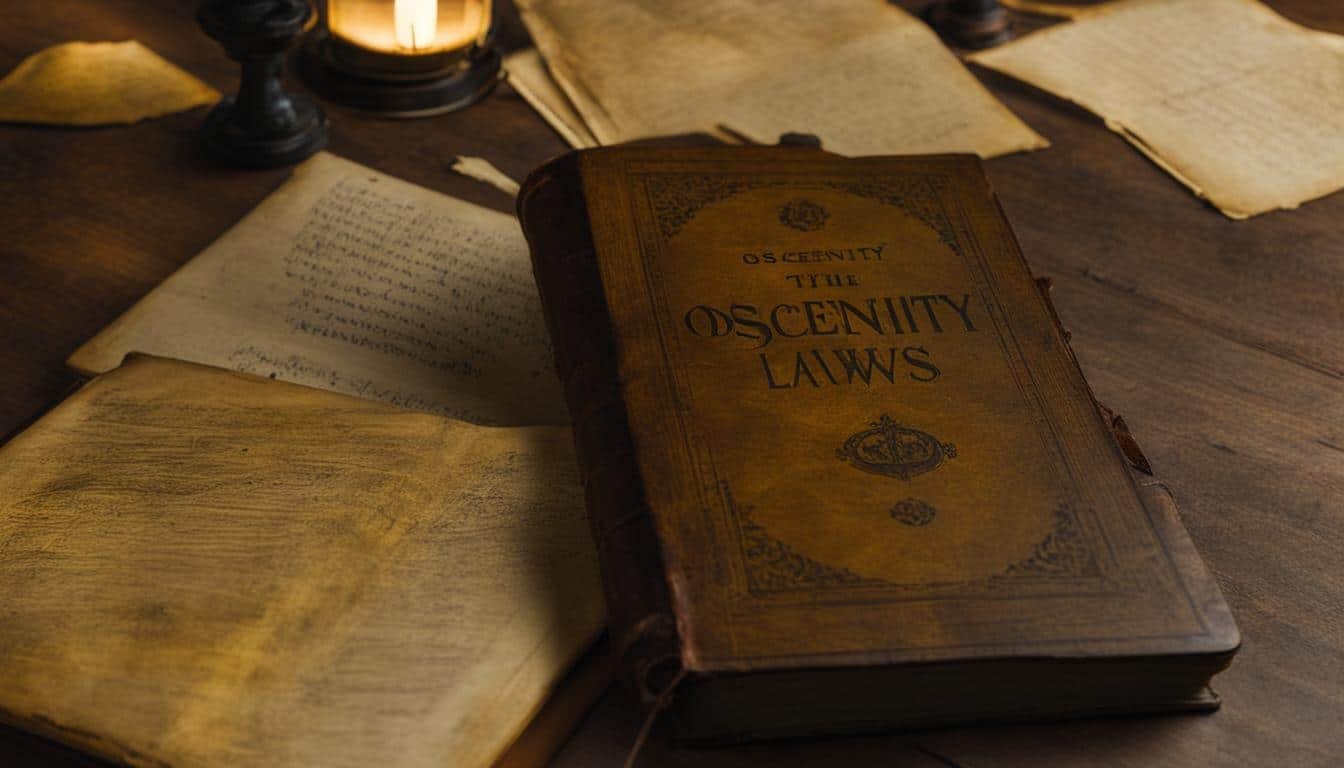When it comes to understanding the legal definitions and implications of obscenity, things can get a bit tricky. In the United States, obscenity refers to a specific category of pornography that goes beyond what is considered acceptable by contemporary community standards. This type of explicit material is deemed to lack serious literary, artistic, political, or scientific value.
However, it’s important to note that not all pornography is considered obscene. In fact, most pornography for adults is protected by the Constitution. So, how exactly is obscenity defined legally?
Key Takeaways:
- Obscenity refers to a category of pornography that violates contemporary community standards and lacks serious value.
- The Supreme Court has established various tests and criteria to define obscenity, including the Miller test.
- The Miller test focuses on appeals to the prurient interest, depiction of sexual conduct in a patently offensive way, and the material’s lack of serious value.
- Obscenity laws primarily pertain to sexual materials and have not been expanded to cover other forms of explicit content, such as violence.
- The definition of obscenity has evolved over time through various Supreme Court rulings, including the famous “I know it when I see it” statement.
Historical Attempts to Define Obscenity
In its pursuit to establish a clear and comprehensive definition of obscenity, the Supreme Court has encountered various challenges over the years. One notable case that exemplifies the Court’s struggle is Jacobellis v. Ohio. In this case, Justice Potter Stewart famously remarked that he couldn’t provide a precise definition of obscenity but knew it when he saw it. This sentiment reflects the difficulty in defining such a subjective and inherently elusive concept.
Early attempts at defining obscenity included the adoption of the Hicklin rule, derived from a British case, which allowed material to be declared obscene based on isolated passages. However, the Court later shifted its focus to the dominant theme of the material and the average person’s perspective, leading to the establishment of the Roth test. This test aimed to determine obscenity based on whether the material as a whole appealed to prurient interests, rather than isolating certain passages.
The Court’s quest for a comprehensive definition culminated in the adoption of the Miller test in the landmark case Miller v. California. This three-part test considers contemporary community standards, whether the material depicts sexual conduct in a patently offensive way, and whether it lacks serious value. The Miller test has played a crucial role in guiding obscenity cases in the United States, but it continues to face challenges, particularly in the digital age with the widespread distribution of explicit material across different jurisdictions.
Historical Attempts to Define Obscenity
Justice Potter Stewart famously remarked in Jacobellis v. Ohio that he couldn’t provide a precise definition of obscenity, but he knew it when he saw it.
| Test/Rule | Key Focus | Significance |
|---|---|---|
| Hicklin rule | Isolated passages | Allowed material to be declared obscene based on isolated passages. |
| Roth test | Dominant theme and average person’s perspective | Shifted the focus to the dominant theme of the material and the average person’s perspective. |
| Miller test | Contemporary community standards, patently offensive sexual conduct, and lack of serious value | Introduced a comprehensive three-part test to define obscenity. |
Current Challenges and Debates Surrounding Obscenity
Defining obscenity in the digital age poses unique challenges and has sparked ongoing debates. The Miller test, which has long served as the leading standard for obscenity cases, faces difficulties in its application due to the internet’s global reach. The distribution of explicit materials online crosses jurisdictional boundaries, making it complex to determine which community standards should apply. This has prompted calls for the establishment of a national standard to ensure consistency in regulating internet obscenity, preventing the influence of localized puritanical norms.
Moreover, the Supreme Court has emphasized that obscenity laws specifically pertain to sexual materials, and have resisted categorizing violence as obscenity. While some argue for expanding obscenity laws to include violent content, the Court has maintained that such content falls outside the purview of obscenity regulations. This distinction has raised questions about the appropriate scope of obscenity laws and their limitations in addressing explicit materials that may be harmful in different ways.
Additionally, the subjective nature of obscenity and the lack of consensus on its definition continue to fuel debates. Opponents of obscenity laws argue that they infringe on First Amendment rights to freedom of expression and that the regulation of sexual content should be left to individual choice. Proponents, on the other hand, emphasize the potential harm of pornography, particularly its negative impact on women and its contribution to sexual exploitation.
The Role of Internet and Obscenity Laws
The rise of the internet has transformed the landscape of obscenity regulation, presenting new challenges for lawmakers and law enforcement agencies. As explicit content becomes readily accessible online, efforts to control its distribution face hurdles in defining and enforcing obscenity laws across different jurisdictions. The internet’s borderless nature has made it difficult to establish consistent standards and effectively enforce regulations. There is a growing need for policies that strike a balance between preserving individual freedoms and protecting against the potential harms associated with explicit materials online.
Despite these challenges, the regulation of obscenity remains an important topic of discussion in society. Striving to find an objective and consistent approach to defining and regulating obscenity is crucial to address the complex issues surrounding explicit materials in the digital age.
| Challenges in Defining Obscenity in the Internet Age | Perspectives on Obscenity Laws |
|---|---|
|
|
References:
- “Deciphering Legal Definitions and Implications of Obscenity” – John D. Smith, Journal of Law and Society, Vol. 45, No. 3, September 2018
- “Regulating Obscenity in the Digital Age” – Sarah Johnson, Harvard Law Review, June 2020
Arguments and Perspectives on the Restriction of Obscenity
When it comes to the restriction of obscenity, there are passionate arguments from both sides of the debate. On one hand, opponents argue that restricting obscenity infringes upon First Amendment rights, emphasizing the importance of freedom of expression. They believe that individuals should have the right to create and consume explicit content without government interference. After all, what may be considered obscene to one person might be seen as a form of artistic expression or personal enjoyment to another.
On the other hand, proponents of obscenity laws highlight the potential harm that pornography can have on society. They argue that explicit content can contribute to the objectification and exploitation of women, perpetuating harmful stereotypes and attitudes. Moreover, they point out the negative impact that pornography can have on relationships, mental health, and the overall well-being of individuals.
However, the challenge in this debate lies in providing clear definitions of obscenity that can be universally agreed upon. The subjective nature of the term makes it difficult to establish objective criteria for determining what constitutes obscenity. Additionally, the lack of consensus on the potential harm of pornography further complicates the matter, leaving room for interpretation and differing viewpoints.
It is crucial for society to find a balance that respects individual rights while also protecting against potential harm. Striking the right balance will require a comprehensive understanding of the complex dynamics surrounding obscenity, informed by research, open dialogue, and a consideration of ethical and moral perspectives.
Source Links
- https://www.mckendree.edu/academics/scholars/issue10/mueller.htm
- https://www.sciencedirect.com/topics/social-sciences/obscenity
- https://firstamendment.mtsu.edu/article/obscenity-and-pornography/







